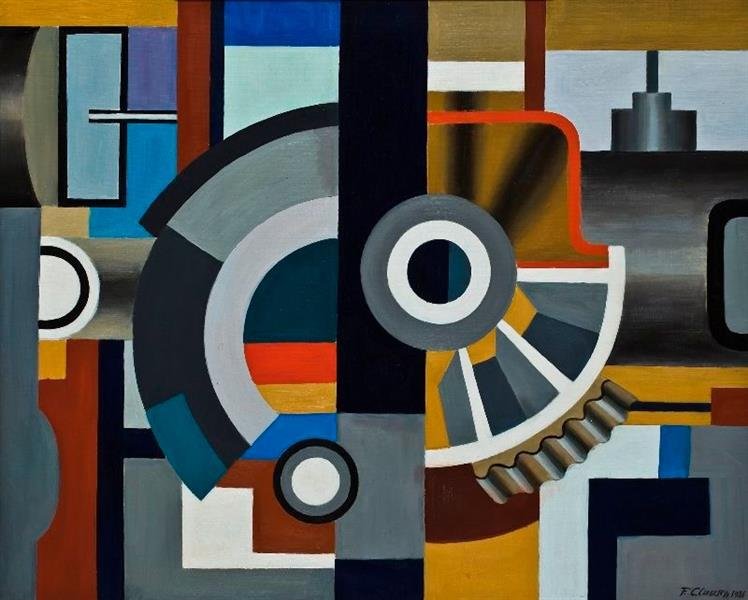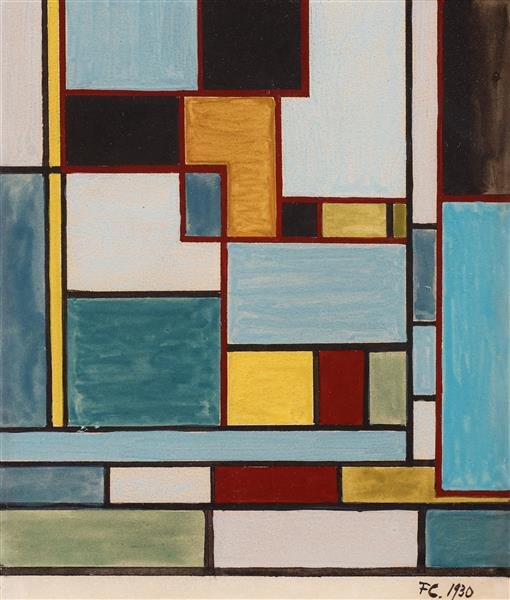Franciska Clausen: Expanding the Notions of Abstraction
By Gustė Matulionytė
Franciska Clausen (1899-1986), a Danish artist best known for her abstract compositions, was closely integrated into various European avant-garde circles. Born in the small town of Aabenraa, Clausen travelled widely as she studied art both in Germany and Denmark. Upon completing her academic artistic education in the early 1920s, she pursued private lessons from László Moholy-Nagy and Alexander Archipenko in Berlin. There Clausen became familiar with Constructivism and Suprematism, and was encouraged to explore the pure forms of geometry as the subject of her art. After moving to Paris in 1924, the young artist quickly incorporated herself into the local avant-garde circles and became a pupil of Fernand Léger. Léger’s Cubism of the 1920s was steeped in machine aesthetics, and Clausen embraced a similar style in her own paintings. Her works of this period, such as Mechanical Element (1926) and The Screw (1926) combine mechanical elements and machine parts with geometric backgrounds in vibrant colours, synthesising influences from both German and Parisian avant-garde circles.
Franciska Clausen, Mechanical Element, 1926.
In the second half of the 1920s, Clausen experimented with a variety of styles of modernism: alongside the abstract movements of Constructivism, Cubism, Neoplasticism, the artist dabbled in New Objectivity and Surrealism. However, even in these works, Clausen never strayed too far from geometric abstraction. Her painting The Fish (1926) combines a realistically rendered image of a fish peeking above a body of water with a background of rectangles and circles, accentuated with wave-like patterns. The geometrical background is tightly constructed – the edges of straight, diagonal, and rounded lines are carefully aligned, and even the arched body of the fish itself follows the perfect curve of a large silver circle.
Franciska Clausen, The Fish, 1926.
Some of Clausen’s most famous abstractions, however, were produced in 1930, when the artist joined the Cercle et Carrégroup of abstract artists, founded in 1929 by Joaquín Torres-García and Michel Seuphor. Though Clausen participated in the group’s only exhibition in April 1930 and actively attended the fortnightly member meetings, contemporary accounts indicate that she was not an active participant in the theoretical discussions of the group. Later in life Clausen noted that women were not taken seriously in Cercle et Carré – an account that seems to be corroborated by the low number of female artists to being published in the group’s journal, despite the fairly equal gender division in the group itself. It has ben suggested that Clausen’s role in the periphery, however, enabled her to experiment with the tenets of abstraction without being met with scathing criticism from the leading members of the group, such as Piet Mondrian. In Neoplastic Composition (1930), Clausen strayed from Mondrian’s strictly defined principles of black or white grid lines containing rectangles of primary blue, red, and yellow, and white, grey, and black. Though the grid structure of the composition is conventional, Clausen uses red for the lines of the grid, and expands her colour palette to include green, as well as various shades of blue and yellow as opposed to solely primary hues. The resulting composition is less rigid than that the Neoplastic works of her contemporaries, imbued with visual dynamism rather than just the strict geometric principles.
Franciska Clausen, Neoplastic Composition, 1930.
In 1930 Clausen also began explorations of circular forms in her geometric abstractions. Although circles and cylinders were present in some of Clausen’s paintings from the 1920s, the curved elements were uncommon among the artists of Cercle et Carré, who mostly worked in Purist or Neoplastic compositions consisting of strict grids and a primary colour palette. The circle marked Clausen’s more personal approach to geometric abstraction, and a deeper exploration of the narrow formal vocabulary that prevailed among her contemporaries. Notably, circles also allowed Clausen to explore some of her personal artistic interests, such as movement and optics. In Circles and Verticals (1930), pairs of circles of varying sizes are connected by vertical lines, creating cylindrical shapes. The sharp distinctions between the colours of the circles themselves and the spaces connecting them echo optical designs and create illusions of movement, as the circles appear to slide vertically against the grey background. A keen interest in optics, specifically afterimagery, is also present in Circles (1930). In this composition, Clausen combines contrasting colours to make the geometric forms function as afterimages of each other, as the red circles are mirrored by their identically sized counterparts in green.
Franciska Clausen, Circles, 1930.
Franciska Clausen, Circles and Verticals, 1930.
Reception of Clausen’s work during her lifetime largely centred on the notion that her abstract compositions were derivative and heavily reliant on the works of her teachers and male avant-garde contemporaries such as Léger. However, a closer examination of Clausen’s artistic production reveals the originality of her abstract oeuvre, and the variety and ingenuity in her combinations of different elements and styles.
Notes:
AWARE Women artists / Femmes artistes. ‘Three Scandinavian Surrealist Women Artists in Paris’. Accessed 16 March 2023. https://awarewomenartists.com/en/magazine/trois-artistes-femmes-surrealistes-scandinaves-a-paris/.
Faxedas, M. Lluïsa. ‘Women Artists of Cercle et Carré: Abstraction, Gender and Modernity’. Woman’s Art Journal 36, no. 1 (2015): pp.37–46.
Højsgaard, Mette. ‘Dealing with Circles: Franciska Clausen and Her Position in the Group Cercle et Carré (1929–1930)’. Electronic book. In Modern Women Artists in the Nordic Countries, 1900-1960, edited by Kerry Greaves, pp.207–17. Routledge Research in Gender and Art. New York; Abingdon, Oxon: Routledge, 2021.
Lovring, Rigmor. ‘Clausen, Franciska’. Grove Art Online. 2003. Accessed 16 March 2023. https://www.oxfordartonline.com/groveart/display/10.1093/gao/9781884446054.001.0001/oao-9781884446054-e-7000018051.





